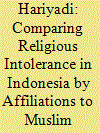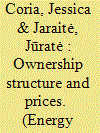|
|
|
Sort Order |
|
|
|
Items / Page
|
|
|
|
|
|
|
| Srl | Item |
| 1 |
ID:
189555


|
|
|
|
|
| Summary/Abstract |
Very few studies explicitly, let alone quantitatively, examine gaps in religious intolerance among individual Muslims based on affiliation with major Muslim organizations in Indonesia. Most existing studies either focus on a single organization (non-comparative), are at the organizational policy level (not examining individual attitudes), or use a limited number of samples in their analysis. Against this backdrop, this study compares Indonesian Muslims’ levels of religious intolerance based on their affiliation with Muslim organizations or traditions: Nahdlatul Ulama (NU), Muhammadiyah, and other organizations. We utilize a large-scale household survey, the 2014 Indonesia Family Life Survey-5, and run an ordinal logistic regression to identify organizations’ rank on the religious intolerance scale. We find that Muslims without any affiliation with a Muslim organization (some 18 percent of Indonesian Muslims) are the most tolerant. Against this reference group, we find that NU followers are generally the most tolerant, followed by those affiliated with Muhammadiyah, and those affiliated with other Muslim organizations. This finding adds a stock of knowledge to our understanding of religion and society, especially regarding interfaith relations in Indonesia and in the Muslim world in general. Methodologically, this study also shows the benefit and feasibility of identifying the dynamic of religious intolerance using a quantitative approach at a micro level.
|
|
|
|
|
|
|
|
|
|
|
|
|
|
|
|
| 2 |
ID:
166465


|
|
|
|
|
| Summary/Abstract |
This paper aims to identify the demand elasticity in energy consumption by Brazilian families. By using an original household-level sample, we are the first to identify the average price and income elasticities for Brazil. We also investigate heterogeneous effects across different quantiles through a Quantile Regression (QR) analysis. Finally, we extend the results of the QR analysis and combine them with aggregated data to assess the effects of two price policies, a cross-subsidy and the recently adopted "tariff flags." The primary data comes from the Household Budget Survey (POF) for two periods, 1998–99 and 2008–13, conducted in the metropolitan area of São Paulo. The price and income elasticities range from −0.46 to −0.56, and from 0.20 to 0.32 respectively. The QR results indicate that households’ behavioral response to a price increase is non-uniform across groups, and that the reaction is stronger for the lower quantiles. Additionally, “tariff flags” lead to a more significant reduction in consumption for the low-income residences, therefore representing a regressive policy. On the other hand, a cross-subsidy that increases the energy price to ordinary residences by 1% could mean a decrease in electricity prices of between 7.5% and 12.4% to low-income families.
|
|
|
|
|
|
|
|
|
|
|
|
|
|
|
|
| 3 |
ID:
192789


|
|
|
|
|
| Summary/Abstract |
This paper studies the ownership structure among participants in the Swedish tradable green certificate (TGC) system and its implications for TGC prices. First, we investigate cross-ownership – a situation when a firm is active on both the demand and supply sides of the TGC market – by linking suppliers and obliged parties to their parent firms. Next, we calculate indexes of market concentration that account for cross-ownership. Finally, we use detailed TGC transaction-level data to analyze differences in the prices of the TGCs traded by cross-ownership versus non-cross-ownership firms. Our results show considerable cross-ownership, with many firms active on both TGC supply and demand sides. However, even after accounting for cross-ownership, the market concentration of the entire TGC market is low and has decreased over time. Despite the absence of market concentration, our analysis of TGC prices indicates that cross-ownership firms have the ability to differentiate TGC prices from non-cross-ownership firms. Such behavior is consistent with the behavioral assumption that the ultimate owner's objective is to maximize the total profit of the portfolio of shares, and that, therefore, the pricing behavior would differ from that of a perfectly competitive firm without ownership links to other firms in the industry.
|
|
|
|
|
|
|
|
|
|
|
|
|
|
|
|
|
|
|
|
|